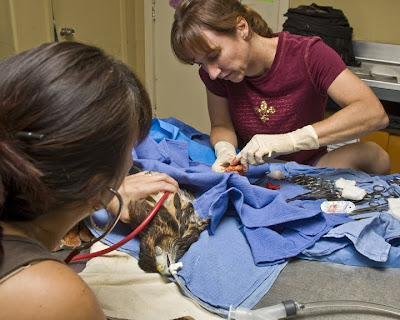Welcome to my first, non-video special edition of TW@L! I've got a few cute pics of new arrivals (these birds seem to think breeding is a year-long activity!), and a bat rescue (one of 4 last week!), followed by the "Surgery Special." Some of the photos are graphic, but it's the kind of interesting activity that happens here. We're lucky to have volunteers that will perform the tasks that are required, and so are the animals. OK, let's get started...

Some little birds came in last week, at least small in size! A tiny baby night hawk arrived, along with several kestrels, some of which look like they are third clutch birds from this year. One very dark female may very well be added to our education collection. She has an apparent wing injury and she seems very comfortable around people - almost too comfortable! We'll have to watch her closely...
One of four bat calls that came in last week took me to Chandler and Basha's High School. The little guy was hanging on the door frame to the music room, and as I was effecting the rescue, one of the students was giving me a drum roll! I've never had music accompaniment to a rescue before!
~~~~~~~~~~~~~~~~~~~~~~~~~~~~~~~~~~~~~~~~~~~~~
Two harris' hawks were scheduled for surgery last week, one for a wing amputaion, and the other to remove badly burned toes. Dr. Wyman performed the surgery with Jan Miller assisting.


The first bird had an injury to the right elbow which we thought would require the wing to be amputated. When the wrapping was removed, it appeared the wound had healed far better than anticipated so after a bit of cleaning, the wing was left intact. More observation is in order, so keep your fingers crossed for this bird!


Three days later, she is standing on the foot!
Of the five most common injuries we see at Liberty, electrical burns are some of the hardest to treat. In lots of cases, the burning happens from within and days after the initial contact, the animal begins to show the first signs of damage. In the case of this harris' hawk, she must have landed on a wire and somehow grounded herself, causing her foot to complete the circuit. A couple days later, the toes on one foot began to die and turn black. Two fell off altogether. It was decided to amputate the dead digits, leaving enough foot for her to stand. She should be able to handle food with her good foot. Dr.Wyman performed with complete professionalism, skillfully removing the toes and suturing the wounds closed afterward. In view of the extent of the surgery, the bird got a good dose of pain medication to avoid undue suffering the next day, and within three days, was standing normally on the foot.





















No comments:
Post a Comment